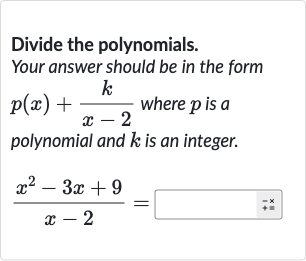Full solution
Q. Divide the polynomials. Your answer should be in the form where is a polynomial and is an integer.
- Set up long division: Set up the long division.We will divide the polynomial by using long division.
- Divide first term: Divide the first term of the dividend by the first term of the divisor. Divide by to get . This will be the first term of the quotient polynomial .
- Multiply divisor: Multiply the divisor by the term obtained in Step .Multiply by to get .
- Subtract result: Subtract the result of Step from the dividend.Subtract from to get .
- Bring down next term: Bring down the next term of the dividend.Since there are no more terms to bring down, we proceed to the next step.
- Divide new term: Divide the new term of the dividend by the first term of the divisor. Divide by to get . This will be the next term of the quotient polynomial .
- Multiply divisor again: Multiply the divisor by the term obtained in Step ext{ extdollar} ext{ extdollar}.Multiply ext{ extdollar}(x - ) ext{ extdollar} by ext{ extdollar} ext{ extdollar} to get ext{ extdollar}-x + ext{ extdollar}.
- Subtract result again: Subtract the result of Step from the new dividend.Subtract from to get .
- Check remainder: Since the degree of the remainder () is less than the degree of the divisor (), we cannot continue the division.The remainder is , and the quotient polynomial is .
- Write final answer: Write the final answer in the form . The quotient polynomial is , and the remainder is , so the final answer is .

